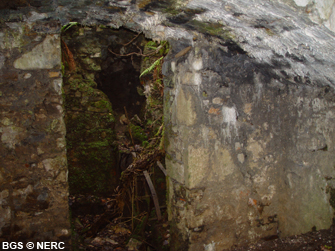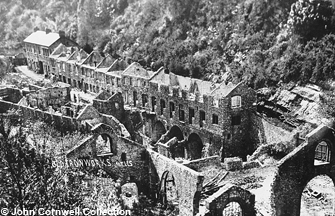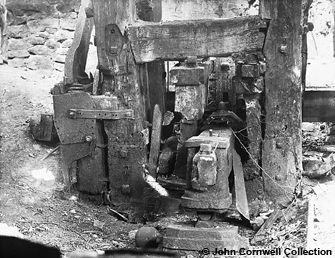
Minerals and mines
Industrial archaeology — Fussell's iron works

The area around Mells, Great Elm and Chantry and Nunney is 'Fussell country'. In the late 18th and early 19th centuries, the Fussell family ran a highly successful iron works business producing edge tools such as scythes, sickles, spades, shovels and other agricultural implements. The Fussells were first mentioned in a parish register in 1644, but it wasn't until 1744 that the first iron works were established in Mells by James Fussell III.
His two sons, Austin and James IV (1748–1832) continued and expanded the business at Mells while another son, John Fussell opened a second works at Nunney by 1766. James IV was also involved in the design of the proposed Dorset and Somerset Canal, and in 1798 he patented a new type of 'balance lock' or boat lift which was built at Barrow Hill near Frome. Although it was successfully trialed, the canal was never completed and the lift fell into disrepair.
The company continued to prosper and by the turn of the century the company was exporting their wares to Europe and America. In the early 19th century the Fussells were running six iron works. Three of these were along the Mells River between Mells and Great Elm. Another two were sited in Railford Bottom near Chantry, and one just north of Nunney.
The company continued under the stewardship of the next generation of Fussells, James V, John III and Thomas, followed later by James VI who became the Vicar of Chantry in the late 19th century. By this time the iron making industry was in decline. A reliance on water power, coupled with the collapse of English agriculture in the 1870s forced the company to modernise and diversify their business but too little was done too late. In 1882, a new company was formed to take over the running of the business but by 1894 this too was bankrupt. The company was taken over by Isaac Nash and the business moved to Worcestershire.
The remains of the six works can still be seen. Two have been restored as private residences, but the others lie in ruins, the most impressive of which are the Upper and Lower works near Mells.
Mells – Upper Works
This site lay at the upper end of the Wadbury valley, just downstream of Mells. The works were in operation in 1804, and were probably abandoned at the same time as the Lower Works farther down the valley in latter part of the nineteenth century. The site continued to exist as a water-powered sawmill throughout the first half of the 20th century, and possibly as late as the 1960s. Certainly the walls were repaired in 1952. However, little remains today except the outline of some of the walls and the remains of the sluices and water races.
There have been at least eight water wheels on the site, powering the tilt hammers and grinding machinery. The water was fed through a complex series of stone-lined tunnels to emerge at a tail race 250 m farther down valley. Mosses, liverworts and small wall ferns now thrive in the ruins, while the stone buildings, and the labyrinth of flues and tunnels are now home to a large roost of greater and lesser horseshoe bats. These rare bats are relatively widespread in Mendip caves and mines, and, unlike other British bats, can easily be recognised by their free-hanging roosting habit.
Mells – Lower Works

Farther down the valley are the impressive remains of Fussell's Lower iron works, set up in 1744 by James Fussell on the site of an earlier works run by James Naylor. Iron ore was not smelted on site but brought in as scrap or pig iron, although there is some evidence that steel was made on site. During the heyday over 250 people were employed here. An inventory of 1804 lists the following stock held at the works: 1700 dozen scythes, 500 dozen reap hooks, 80 tons of old iron, 25 tons of bar iron, 9 water wheels and forges, hammers and other machinery.
Great Elm Edge-Tool Works
The Great Elm works are located on the Mells river 150 m downstream from the confluence with Fordbury Bottom. Now a private house, the site was a typical water-powered edge-tool works with at least three water wheels of which one still remains. The large pond just upstream is the former millpond. It was probably constructed in 1792 as part of the expansion of the Fussell's works at Mells, and extended between 1814 and 1839.
Chantry Works
James Fussell V, the grandson of the James Fussell III lived in 'The Chantry', close to the Chantry works. This large villa, built in 1825, is set in landscaped grounds just south of Chantry Church. Chantry Pond was a feature of these grounds, but also served as the mill pond for the Chantry iron works just downstream. The date of construction of the iron works is unclear, but it appears to have been built between 1817 and 1840, but probably closed in 1894 at the same time as the other Fussell iron works. The works included a blast furnace.
Railford Works
Railford iron works lie 650 m downstream of Chantry Pond, near Railford Bridge. Like Chantry, the iron works here were a branch of the main works at Mells. It was auctioned off in 1886 when the Fussells were declared bankrupt, but continued to operate as a saw-mill, finally closing in the 1930s. It is now a private house, but some remains of a few walls, sluices, tunnels and a chimney can be seen. The adjacent ruins suggest that the building once housed a beam engine, used to lift water to power the water wheels in times of low water.
Nunney Works

John Fussell set up his iron works in Nunney in the latter part of the 18th century; Land Tax records indicate that he owned and occupied 'Late Hoddinots Mill' by 1766. The site was sold in 1846, and the sale included 'a mill, water wheels and water courses, sheds, smiths' shops, carpenters' shops, grinding house, store houses, workman's cottages, gardens and other premises'. At the time, thirty experienced workmen were employed there. All that remains now is a jumble of ruined buildings, including the remains of the manager's office, old trip hammer shops and a millpond.
Gurney Slade
Another small iron works was in operation at Gurney Slade. The works employed 13 men, mostly making shears, and was powered by three water wheels; one large one for a primitive water-powered hammer and two for driving bellows. Most of the site was destroyed when the waterworks were rebuilt in the 1930s and little now remains. The hammer was recorded and photographed by a Dr Reid and the photos can now be seen in the Wells and Mendip Museum.
- Home
- Overview maps
- Locality
areas
- Cheddar Gorge
- Charterhouse
- Blackdown
- Burrington Combe
- Shipham & Rowberrow
- Crook Peak & Axbridge
- Banwell to Churchill
- Priddy
- Harptree & Smitham Hill
- Draycott & Westbury-sub-Mendip
- Wookey Hole & Ebbor Gorge
- Wells
- Great Elm & Vallis Vale
- Mells & the Wadbury Valley
- The Vobster area
- The Whatley area
- Torr Works & Asham Wood
- Beacon Hill
- Stoke St Michael & Oakhill
- Holwell & Nunney
- Shepton Mallet & Maesbury
- Gurney Slade & Emborough
- The Nettlebridge valley
- Geology
- Minerals and mines
- Quarrying
- Caves and karst
- Biodiversity
- Detailed site information
- Acknowledgements
- External links
- Search
- Site map